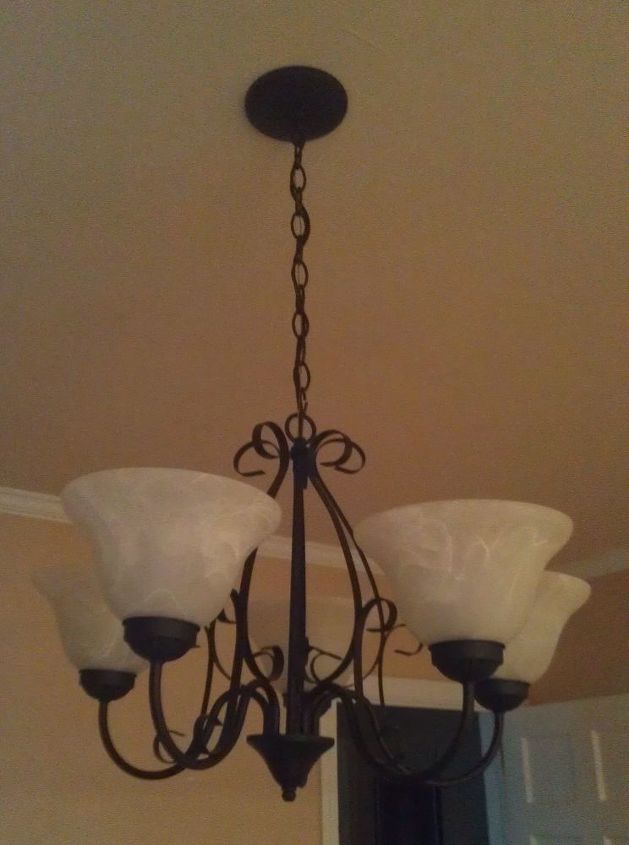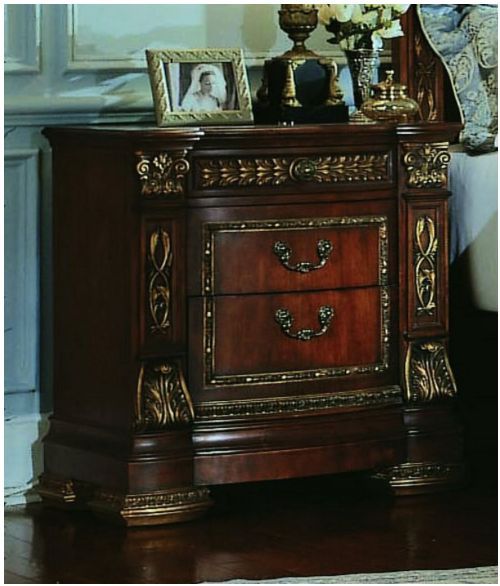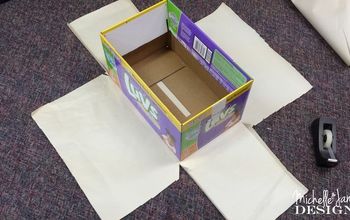Novice's question on replacing light fixture

Right now the bulbs face up toward the ceiling. One of the reasons I don't like the fixture is because of that upward lighting -- it's awfully bright. I want something that still is bright (because this is a dark room) but not as bright as this. I've been thinking of a large pendant lamp with a shade but I wonder if that will be too dim. Any thoughts on basic styles to consider?. Nothing design-y, please.
-
If you go with a pendant type of light, keep in mind that it is above eye level and you will be looking directly at the light bulbs. Instead of replacing the whole fixture, try using lower wattage bulbs or install a dimmer switch. That way, you can adjust the light to the desired intensity. That is a lot easier and more cost effective than replacing the whole fixture.
 WallsTreat Studio/ Kass Wilson
on Aug 24, 2012
Helpful Reply
WallsTreat Studio/ Kass Wilson
on Aug 24, 2012
Helpful Reply -
-
This can be a DIY type of project. You can pick up pretty much in most home centers in the book section basic wiring for exactly this type of job. It is pretty simple. When you turn off the power and remove the cover, you will see a metal flat bar in most cases that is fastened to two corners of the ceiling box. Remove these and replace once again with the new one. As far as wattage, The more bulbs the greater the wattage. Most basic fixture wiring will handle pretty much anything that will hang on the box that is installed. So you really do not have to worry much about that. I would however, purchase a dimmer rated for the wattage of the new fixture and replace the switch you currently have now. If there are two locations in which you can be to turn on and off the fixture, you need what is called a Three Way dimmer switch. Simply choose one or the other switch location and mark the wires where they were on the old switch and put them back on the new one in the same place. Be sure again to turn off the power. When doing this, turn on the light and continue to switch off breakers until the light goes off. Tape the breaker in the off position and mark the panel to what it does for future work you may want to do. The only time I would suggest that you bring in an electrical contractor is if you decide to install a really large or extremely heavy light fixture. But unless this is a foyer and your planning to install one of those large glass type fixtures or a paddle fan, do not worry. It is a pretty simple job. Just be sure you have a few hands around to hold the fixture in place until it is fastened into place.
 Woodbridge Environmental Tiptophouse.com
on Aug 24, 2012
Helpful Reply
Woodbridge Environmental Tiptophouse.com
on Aug 24, 2012
Helpful Reply -
-
I like the idea of a dimmer switch, it saves power and lets you control the brightness for the situation, and it's easy to install in the place of the light switch and cheaper....Ya'll already gave her the best suggestions and information all I can do is say...hey a dimmer switch is a cheap fix if brightness is the problem...LOL!
 Sharron W
on Aug 24, 2012
Helpful Reply
Sharron W
on Aug 24, 2012
Helpful Reply -
-
There is a great website by Pretty Handy Girl that covers all kinds of home projects. I just checked and she has a tutorial that shows you exactly how to replace a ceiling light by yourself. Check it out here: http://www.prettyhandygirl.com/2011/02/new-light-fixtures-to-light-up-your.html
 Sinkadoodles Decals
on Aug 25, 2012
Helpful Reply
Sinkadoodles Decals
on Aug 25, 2012
Helpful Reply -
-
I second the dimmer switch...By using the higher wattage bulbs that the fixture is rated for ...you will have a wider range of "light" with a dimmer...from full to just a faint glow. using lower wattage bulbs will not allow you to crank it up when needed. Keep in mind dimmers love incandescent bulbs and will not work with CFL's
 KMS Woodworks
on Aug 25, 2012
Helpful Reply
KMS Woodworks
on Aug 25, 2012
Helpful Reply -
-
There is a dimmer that is designed just for CFL bulbs. However it is expensive so you will know when you purchase it. Also be sure that the dimmer is rated for the wattage that the fixture it is going to dim otherwise the dimmer will overheat which is not a safe condition. I run into that issue many times when doing home evaluations. The owner puts in much large bulbs and forgets that the dimmer is only rated for what was first put in. When i put my hand on the switch, I could feel the heat being generated out of the switch box itself.
 Woodbridge Environmental Tiptophouse.com
on Aug 25, 2012
Helpful Reply
Woodbridge Environmental Tiptophouse.com
on Aug 25, 2012
Helpful Reply -
-
Thanks, everyone -- it sounds like a dimmer switch is the way to go. Much appreciated!
 Melissa G
on Aug 25, 2012
Helpful Reply
Melissa G
on Aug 25, 2012
Helpful Reply -
-
I would say shut off that rooms electric and do it yourself..by putting white on white black on black and the other on the same screw they used before!! Done it for yrs!!
 Kay C
on Aug 25, 2012
Helpful Reply
Kay C
on Aug 25, 2012
Helpful Reply -
-
Yep a dimmer switch is something you can do yourself, as long as you double check that you've turned off the correct circuit breaker....
 Sharron W
on Aug 25, 2012
Helpful Reply
Sharron W
on Aug 25, 2012
Helpful Reply -
-
Melissa....as I am local, call me if you have any questions. Depending on the wiring in the junction box, you may have a red wire also. The red would be used for the lighting on a ceiling fan. Just mark the two wires (white and most likely black) that the old fixture is connected to (in addition the the bare copper "ground" wire. And please make sure that the wire nut connectors are twisted very tight. Is there more than 1 light switch that controls this fixture......if there are two, you will need a 3 Way Dimmer to replace one of the two switches. Gary PS: Although stated above....NEVER use a lamp of a wattage output greater than recommended by the manufacture. By doing do, you create an unsafe environment and if left at the highest level of the dimmer, you will create a potential fire hazard. As I told a customer today when he complained on how picky I was about putting some open wire connections in his attic into a junction box with a cover......"The primary job of the Electrician is to Save Lives and prevent fires".
 LandlightS
on Aug 25, 2012
Helpful Reply
LandlightS
on Aug 25, 2012
Helpful Reply -
-
I agree completely, Landlight$. The reason for the wattage restrictions on any fixture is to prevent an electrical fire. I have a dimmer switch on my dinning room light and have CFL bulbs in them. I enjoy the fact that I can change the amount of light and still save $$ on my electric bill.
 Kelly S
on Aug 25, 2012
Helpful Reply
Kelly S
on Aug 25, 2012
Helpful Reply -
-
Sounds like you are new to dealing with electrical. While this is not an impossible task, you can get hurt very seriously, very quickly if you do not know what you are doing. My hubby grew up learning how to deal with this and it still makes me very nervous. If I had to do it, I would either leave it as it is or call in a professional. There is a lot of info you need with electrical, voltage, wattage, limits on these, etc. What you may want to do it take it down and redesign it. Since you say the room is dark, do not limit your light by putting in a lot less light, but go with the dimmer switch so that you have a choice. Good luck.
 Jeanette S
on Aug 26, 2012
Helpful Reply
Jeanette S
on Aug 26, 2012
Helpful Reply -
-
Here would be the swing issue for me. While it is not hard to replace a fixture that has a single switch (disregarding for the moment the whole holding it so the wires are not strained and working on top of a ladder thing), it becomes somewhat problematic when there are two switches involved. My husband and I have replaced many a fixture together over the years. It often involves swearing because completing the circuit is easy but gravity is not your friend in this situation. However, we recently ran into tremendous challenges with a kitchen fixture wired to two switches and ended up calling an electrician. His take on the situation--there are many, many acceptable configurations for wiring a double switch and he advised using a pro in these instances. I have to say, I think his advice was sound.
 Lori J
on Aug 26, 2012
Helpful Reply
Lori J
on Aug 26, 2012
Helpful Reply -
-
I wanted to offer my experience on doing exactly as you're wanting to do Melissa. I followed the instructions of my new light fixture and installing it was a breeze. Just takes a number of steps. My particular fixture has a 60 watt center light and 5 outer lights. I decided to put the fixture on a dimmer switch. The light fixture said the maximum wattage per bulb fixture was 100 watts. I installed 5 100 watt bulbs and it turned the dimmer switch into a boiler plate aka it was hot to the touch even though the dimmer switch was rated for over 500 watts. I installed CFL bulbs that used 20 watts per bulb which significantly cut down on the energy usage as well as the temperature of the switch. My next problem was discovered when I dimmed the CFL bulbs all way down. This generated a buzzing noise from each light which when combined, was definitely noticeable. I read up on the issue and switched out the dimmer switch with an expensive one specifically for CFL bulbs but that didn't help the problem. At the end of the day, I said the hell with it and used soft white CFL bulbs with a standard switch which solved all my other problems. Please keep this all in mind when working with your new fixture.
 Jeff C
on Aug 26, 2012
Helpful Reply
Jeff C
on Aug 26, 2012
Helpful Reply -
-
If you read the fine print on the dimmer package the aluminum face plate is the heat sink for the dimmer. If these are used in a "gang" setting where some of the side tabs need to be removed this lowers the over all wattage rating of the dimmer...(less surface area to dissipate the heat)
 KMS Woodworks
on Aug 26, 2012
Helpful Reply
KMS Woodworks
on Aug 26, 2012
Helpful Reply -
-
Point of information: All solid state dimmers use an electrical component called a triac. A triac is a semiconductor, like a transistor, which can vary the amount of electricity it can pass. As electricity flows through this component, heat is built up and must be dissipated somewhere, most commonly it is dumped into the metal mounting bracket. This is the metal plate on the front of the switch. This heat in turn is transferred to the switch cover plate. In most cases, it is not noticeable when the dimmer switch is driving a single bulb or a load of 100 watts or so. The heat does become more noticeable when the wattage of the load gets above 300. All single gang dimming wall switches must be able to dissipate one watt of internal power (heat) for every 100 watts of controlled load. At full load, this pushes the internal and external temperatures to the safe limits imposed by UL. This isn't to imply that higher wattage ratings are dangerous. As long as the total wattage is below the rating printed on the dimmer, you can rest assured that it is safe to use in your home. Thanks to Smarthome for this information.....I can say it, but I am far from a technical writer. Also, as KMS stated above, read the face plate and if used in a multi-gang, junction box (multiple switches) you must derate the function of the dimmer. That is the reason for the standard 600 Watt Dimmer (most conman) and the 1000 Watt and 1500 Watt Dimmers. Gary
 LandlightS
on Aug 26, 2012
Helpful Reply
LandlightS
on Aug 26, 2012
Helpful Reply -
-
Just to update you all -- we installed the dimmer switch (there was only one switch, so we could do it) and the result is terrific. Being able to dim has made the light so much more useful -- we can use it in so many different ways now. Thanks for the suggestions!
 Melissa G
on Sep 13, 2012
Helpful Reply
Melissa G
on Sep 13, 2012
Helpful Reply -
-
AWESOME Melissa! I LOVE the ambiance "potential" of a dimmer switch...LOL
 Sharron W
on Sep 13, 2012
Helpful Reply
Sharron W
on Sep 13, 2012
Helpful Reply -
-
Don't you just love it when a plan comes together!
 Woodbridge Environmental Tiptophouse.com
on Sep 13, 2012
Helpful Reply
Woodbridge Environmental Tiptophouse.com
on Sep 13, 2012
Helpful Reply -
-
@WE are you sure we're not related? That's my family's phrase....LOL
 Sharron W
on Sep 14, 2012
Helpful Reply
Sharron W
on Sep 14, 2012
Helpful Reply -
-
and a dimmer is a lot cheaper on the wallet than a whole new fixture
 KMS Woodworks
on Sep 14, 2012
Helpful Reply
KMS Woodworks
on Sep 14, 2012
Helpful Reply -
-
@KMS Oh YEAH for sure...and less trouble to install as well...
 Sharron W
on Sep 14, 2012
Helpful Reply
Sharron W
on Sep 14, 2012
Helpful Reply -
-
Glad that worked out for you.
 WallsTreat Studio/ Kass Wilson
on Sep 15, 2012
Helpful Reply
WallsTreat Studio/ Kass Wilson
on Sep 15, 2012
Helpful Reply -
-
I haven't read all of the responses to your question but, did you consider replacing your bulbs with a lower wattage! My personal preference is to have the shades facing upwards as I don't want to see the bulbs 'staring' down at me.
 Sandra K Salisbury
on May 12, 2016
Helpful Reply
Sandra K Salisbury
on May 12, 2016
Helpful Reply -
Related Discussions
Blackout curtains behind vertical blinds
I have two 6' patio doors, and I want to add blackout curtains to keep the sun/cold out. What is the best way to hang them, and what can I use to push the curtains ba... See more
How to make a balloon garland?
Does anyone know how to make a balloon garland or a balloon arch?
Does anyone know what this is?
Just turn them upside down and open them, then insert a roll of paper towel and tada, you have yourself a brand new paper towel holder that is not only beautiful, but... See more
Can anyone identify this vintage wooden crank box?
The item is solid wood, standing aprx. 26" high x 16" wide, no exterior holes or outlets, side crank handle turns four wooden paddles inside with various size holes o... See more
What to put in this huge mason jar?
I have a HUGE mason jar. I would like some ideas on what to put in it for decorations, other than flowers.
How can I find discontinued Pulaski or Neiman Marcus/Horchow furniture
I am looking for the discontinued Pulaski Royale collection nightstand, Neiman Marcus/Horchow also sold it, but called it the Royalty collection. I have looked all ov... See more
Ideas on different things I can do with these yummy old spools?
I'm a picker and came across lots and lots of these beauties. I took home several boxes of these purdies and are using for different projects. However, I want to find... See more






